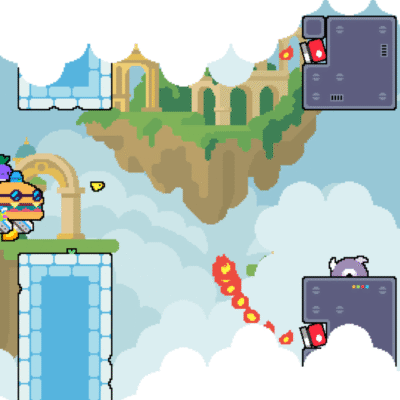This week was an exciting one for the AI community, as Apple joined Google, OpenAI, Anthropic, Meta and others in the long-running competition to find an icon that even remotely suggests AI to users. And like everyone else, Apple has punted.
Apple Intelligence is represented by a circular shape made up of seven loops. Or is it a circle with a lopsided infinity symbol inside? No, that’s New Siri, powered by Apple Intelligence. Or is New Siri when your phone glows around the edges? Yes.
The thing is, no one knows what AI looks like, or even what it is supposed to look like. It does everything but looks like nothing. Yet it needs to be represented in user interfaces so people know they’re interacting with a machine learning model and not just plain old searching, submitting, or whatever else.
Although approaches differ to branding this purportedly all-seeing, all-knowing, all-doing intelligence, they have coalesced around the idea that the avatar of AI should be non-threatening, abstract, but relatively simple and non-anthropomorphic. (They seem to have rejected my suggestion that these models always speak in rhyme.)
Early AI icons were sometimes little robots, wizard hats or magic wands: novelties. But the implication of the first is one of inhumanity, rigidity and limitation — robots don’t know things, they aren’t personal to you, they perform predefined, automated tasks. And magic wands and the like suggest irrational invention, the inexplicable, the mysterious — perhaps fine for an image generator or creative sounding board, but not for the kind of factual, reliable answers these companies want you to believe AI provides.
Corporate logo design is generally a strange concoction of strong vision, commercial necessity and compromise-by-committee. And you can see these influences at work in the logos pictured here.
The strongest vision goes, for better or worse, to OpenAI’s black dot. A cold, featureless hole that you throw your query into, it’s a bit like a wishing well or Echo’s cave.

Biggest committee energy goes, unsurprisingly, to Microsoft, whose Copilot logo is effectively indescribable.
But notice how four of the six (five of seven if you count Apple twice, and why shouldn’t we) use pleasant candy colors: colors that mean nothing but are cheery and approachable, leaning toward the feminine (as such things are considered in design language) or even the childlike. Soft gradients into pink, purple and turquoise; pastels, not hard colors; four are soft, never-ending shapes; Perplexity and Google have sharp edges, but the former suggests an endless book while the latter is a happy, symmetrical star with welcoming concavities. Some also animate in use, creating the impression of life and responsivity (and draw the eye, so you can’t ignore it — looking at you, Meta).
Overall, the impression intended is one of friendliness, openness and undefined potential — as opposed to aspects like, for example, expertise, efficiency, decisiveness or creativity.
Think I’m overanalyzing? How many pages do you think the design treatment documents ran for each of these logos — over or under 20 pages? My money would be on the former. Companies obsess over these things. (Yet somehow miss a hate symbol dead center, or create an inexplicably sexual vibe.)
The point, however, is not that corporate design teams do what they do, but that no one has managed to hit on a visual concept that unambiguously says “AI” to the user. At best these colorful shapes communicate a negative concept: that this interface is not email, not a search engine, not a note app.
Email logos often figure as an envelope because they are (obviously) electronic mail, both conceptually and practically. A more general “send” icon for messages is pointed, sometimes divided, like a paper plane, indicating a document in motion. Settings use a gear or wrench, suggesting tinkering with an engine or machine. These concepts apply across languages and (to some extent) generations.
Not every icon can allude so clearly to its corresponding function. How does one indicate “download,” for instance, when the word differs between cultures? In France, one telécharges, which makes sense but isn’t really “download.” Yet we have arrived at a downward-pointing arrow, sometimes touching down on a surface. Load down. Same with cloud computing — we adopted the cloud despite it being, essentially, a marketing term for “a big datacenter somewhere.” But what was the alternative, a tiny datacenter button?
AI is still new to consumers who are being asked to use it in place of “other things,” a highly general category that purveyors of AI products are loath to define, since to do so would imply that there are some things AI can do and some it can’t. They are not ready to admit this: The whole fiction depends on AI being able to do anything in theory, it being but a matter of engineering and compute to achieve it.
In other words, to paraphrase Steinbeck: Every AI considers itself as a temporarily embarrassed AGI. (Or I should say, is considered by its marketing department, since AI itself, as pattern generator, considers nothing.)
In the meantime, these companies must still call it by a name and give it a “face” — though it is telling, and refreshing, that no one actually chose a face. But even here they are at the whim of consumers, who ignore GPT version numbers as an oddity, preferring to say ChatGPT; who can’t make the connection with “Bard” but acquiesce to the focus-tested “Gemini”; who never wanted to Bing things (and certainly not talk to the thing) but don’t mind having a Copilot.
Apple, for its part, has taken the shotgun approach: You ask Siri to query Apple Intelligence (two different logos), which occurs within your Private Cloud Compute (unrelated to iCloud), or perhaps even forward your request to ChatGPT (no logo permitted), and your best clue that an AI is listening to what you’re saying is … swirling colors, somewhere or everywhere on the screen.
Until AI is itself a bit better defined, we can expect icons and logos representing it to continue to be vague, unthreatening, abstract shapes. A colorful, ever-shifting blob wouldn’t take your job, would it?



